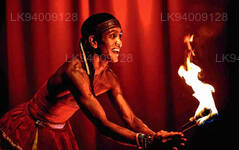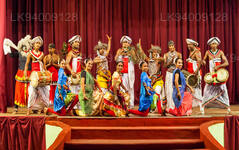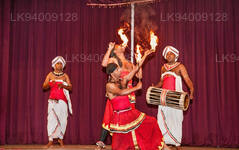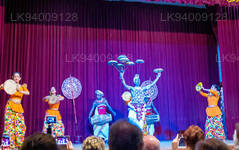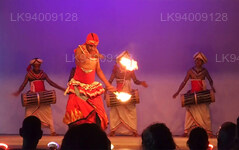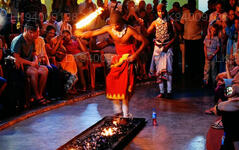
Kandy Şehri
Sri Lanka'nın merkezinde yer alan pitoresk bir şehir olan Kandy, zengin kültürel mirası, canlı festivalleri ve doğal güzellikleriyle ünlüdür. Yemyeşil tepelerin arasında yer alan Kandy, UNESCO Dünya Mirası Listesi'nde yer alan Diş Kalıntısı Tapınağı'na ev sahipliği yapar ve tarih ile doğal güzelliklerin büyüleyici bir karışımını sunar.
Kandy Cultural Show
The Kandy Lake Club Cultural Dance Show is a stimulating Sri Lankan Arts, Dance & Cultural Heritage Show that is a must see for any visitor who visits the historic city of Kandy. The Kandy Lake Club Dance started in 1982 with the view of having a cultural dance performance bringing together all Sri Lankan dance types to one platform. It is the first Cultural Dance Show of its kind to be established in Sri Lanka. It has since become a tourist attraction for many people visiting the country and keen on a glimpse of its rich cultural heritage. Hence it has been performing continuously for the last 35 years. Dance techniques unique to areas of the island are usually passed on from generation to generation. These Dances are performed at local ceremonies and rituals using drums and costumes that are unique to each area. Among the attractions are the Dances depicting the majestic walk of the elephant, colourful performance of the peacock and the mystical movements of the cobra. There are also dances with traditional masks, traditional drums and flames. The show ends with the unbelievable feat of walking on red-hot charcoal, which is a traditional form of worship of local gods. Right throughout the show you can enjoy the sounds of drums and other traditional musical instruments of Sri Lanka.  A hand out in different languages gives our customers a description of every item with all interesting facts and features of the dance show.
The Kandy Lake Club Cultural Dance Show is a stimulating Sri Lankan Arts, Dance & Cultural Heritage Show that is a must see for any visitor who visits the historic city of Kandy. The Kandy Lake Club Dance started in 1982 with the view of having a cultural dance performance bringing together all Sri Lankan dance types to one platform. It is the first Cultural Dance Show of its kind to be established in Sri Lanka. It has since become a tourist attraction for many people visiting the country and keen on a glimpse of its rich cultural heritage. Hence it has been performing continuously for the last 35 years.
- Magul Bera: The blowing of the Conch Shell is the traditional invocation at the commencement of any function and the drums are an integral part of the ritual. It is an ancient Sinhala custom to present ritual music when seeking the blessings of the Guardian of the land.
- Puja Natuma: The female dancers carrying oil lamps are making an offering of their dancing skills to the Guardian Deities.
- Devol Natuma: A dance sequence performed for general immunity from evil influences as well as for healing specific ailments. It is a part of a ceremony connected with folk believes. The vigorous movements of the dancers are derived from the dance forms of the Southern parts of Sri Lanka.
- Mayura Natuma:The female dancers depict the graceful movements of the peacock which according to mythology is the bird that transports Skanda, the War-God of Ceylon, worshipped by Buddhists and Hindus alike.
- Pantheru Natuma: The name of the dance is derived from the musical instrument used, the pantheru, which is close akin to the tambourine. Rhythm is also provided by the accompanying drums. The dance itself shows Sinhala warriors on their way to battle.
- Raksha Natuma: A South Sri Lanka mask dance with the raksha masks symbolising the fight between a cobra and a bird. This dance is used to exorcise demons from the possessed and is still believed to be effective psychiatric treatment in Sri Lanka.
- Lee Keli Natuma: A dance popular in the all parts of the country, particularly during festivals in which both male and female dancers participate. Each dancer has two sticks and the sound of the sticks striking each other together with those of the accompanying drums provide the rhythm for the dancers.
- Raban Natuma: A traditional folk dance which uses the Rabana, an instrument similar to the drum. The popular Ath Rabana (hand Rabana) is almost one foot in diameter and is both played and wielded in a variety of forms by the male and female dancers. Raban playing is accompanied by singing too.
- Gini Sisila: A south Ceylon fire dance showing the power of charms over fire and the twenty seven devils that can trouble mankind. The absolute faith of the fire dancers protects them from the flames. This dance also includes fire-eating.
- Ves Natuma: This dance is the one of the most important forms of Kandyan dance. Ves is the traditional attire of the Kandyan dancer. Sixty four ornaments complete the dress and traditionally their sheen symbolizes the rays of the sun. It takes years of rigorous training before a dancer can achieve the status of a fully-fledged ves dancer.
- Kulu Natuma: A traditional folk dance performed by village damsels to celebrate a rich harvest. The dance portrays sequences from reaping to winnowing of the grain. This is a buoyant dance providing ample opportunities for displaying feminine grace. It is performed to the accompaniment of light drum beats and the haunting strains of the flute.
- Fire walking: The origin of fire walking can be traced back to the epic story of Rama and Sita. Ravana, the King of Ceylon, had abducted the princess of India, Sita. When Rama her husband (an Indian King) regained her, she proved her chastity during her enforced stay with Ravana, by walking on fire, barefoot and unhurt. The devotees who perform fire-walking seek the divine blessings of Lord Kataragama and Goddess Pattini before they do so.
During the show, you will see several dances which depict the graceful movements of birds and animals, which trace their origins back to the ancient ritual known as the Kohomba Kapkariya, as well as energetic acrobatic performances where the men perform a series of leaping pirouettes and stunts such as plate-spinning and the dramatic ‘fire walk’ which ends the show.
Kandy Bölgesi Hakkında
Kandy bölgesi, Sri Lanka'nın merkez eyaletinde yer almaktadır. Sri Lanka'daki yedi Dünya Mirası Alanı'ndan biri olan Kandy, 16. yüzyılda Kandyan Krallarına ev sahipliği yapmış ve ülkedeki tüm müzik, sanat, el sanatları ve kültürün kaynağı olmuştur. Kolombo'ya yaklaşık 129 km uzaklıktaki Kandy, engebeli bir araziye yerleşmiştir ve tüm gözler, Kandy Gölü'nün büyüleyici bir özellik oluşturduğu şehrin merkezine çekilmektedir. Kandy, Sri Lanka için büyük dini öneme sahiptir, çünkü bu büyüleyici şehirde, Lord Buddha'nın kutsal diş kalıntısının iyi korunduğu Dalada Maligawa veya "Diş Tapınağı" bulunmaktadır. Peradeniya Kraliyet Botanik Bahçesi, şehir merkezinin yaklaşık 5 km batısında, Peradeniya'da yer almaktadır ve yılda 1,2 milyon kişi tarafından ziyaret edilmektedir. Adanın en büyük botanik bahçesidir. Udawatta Kele (Udawatta Ormanı), şehrin kalbinde, Diş Tapınağı'nın hemen kuzeyinde yer alan korunan bir sığınaktır. Kandy, Sinhalaların çoğunlukta olduğu bir şehirdir; Mağribiler ve Tamiller gibi diğer etnik gruplara ait önemli topluluklar da vardır. Kandy, Sri Lanka ekonomisinin merkezi olarak Kolombo'dan sonra ikinci sıradadır. Birçok büyük şirketin Kandy'de şubeleri bulunmaktadır ve tekstil, mobilya, bilgi teknolojisi ve mücevher gibi birçok endüstri burada bulunmaktadır. Şehirde birçok tarım araştırma merkezi bulunmaktadır. Ayrıca ülkedeki tüm müzik, sanat, el sanatları ve kültürün de kaynağıdır. Kolombo'ya yaklaşık 129 km uzaklıktaki Kandy, engebeli bir arazide yer almaktadır ve tüm gözler şehrin merkezine, Kandy Gölü'nün büyüleyici bir özellik oluşturduğu yere çekilir. Kandy, Sri Lanka için büyük bir dini öneme sahiptir, çünkü bu büyüleyici şehirde, Lord Buddha'nın kutsal diş kalıntısının iyi korunduğu Dalada Maligawa veya Diş Tapınağı yer almaktadır.
Merkez İl Hakkında
Sri Lanka'nın Merkez Eyaleti esas olarak dağlık bir araziden oluşur. Eyaletin alanı 5.674 km²'dir ve nüfusu 2.421.148'dir. Bazı büyük kasabalar Kandy, Gampola (24.730), Nuwara Eliya ve Bandarawela'dır. Nüfus, Sinhalese, Tamil ve Mağribilerin bir karışımıdır. Hem tepe başkenti Kandy hem de Nuwara Eliya şehri, Sri Pada ile birlikte Merkez Eyaleti'nde yer almaktadır. Eyalet, 1860'larda yıkıcı bir hastalığın eyaletteki tüm kahve plantasyonlarını öldürmesinin ardından İngilizler tarafından ekilen ünlü Seylan çayının çoğunu üretmektedir. Merkez Eyalet, Kandy, Gampola, Hatton ve Nuwara Eliya gibi tepe istasyon kasabalarıyla birçok turisti çekmektedir. Tapınak dişi veya Dalada maligawa, Merkez Eyaleti'ndeki ana kutsal mekandır. İklim serindir ve yaklaşık 1500 metre yükseklikteki birçok alanda genellikle soğuk geceler olur. Batı yamaçları oldukça yağışlıdır ve bazı yerlerde yılda yaklaşık 7.000 mm yağış görülür. Doğu yamaçları ise sadece Kuzeydoğu musonundan yağış aldığı için orta kurak bölgenin bir parçasıdır. Sıcaklıklar, deniz seviyesinden 1.889 m yükseklikte bulunan Kandy'de 24°C ile Nuwara Eliya'da sadece 16°C arasında değişmektedir. Sri Lanka'nın en yüksek dağları Merkez Eyaleti'nde yer almaktadır. Arazi çoğunlukla dağlık olup, derin vadiler araziyi kesmektedir. İki ana dağlık bölge, Kandy'nin doğusundaki Merkez Masifi ve Knuckles Sıradağları'dır.

